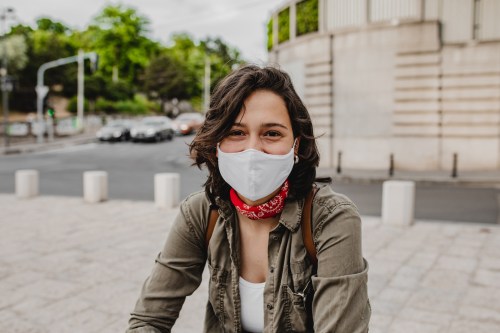These Simple Lung Capacity Exercises Make Mask Breathing Easier
Feel like you're struggling to breathe through your face mask? These pro-approved lung capacity exercises can help your breathe easier.

I will never forget the first time I went out for a run with a mask on. I made it less than a mile before I was out of breath and I had to turn around to walk home. It was clear that my lung capacity was not equipped for this sort of exercise, so I turned to the experts to find out what I could do to help myself breathe easier. And their advice? To put my lungs through some strength training.
Experts in This Article
board-certified allergist and immunologist for Get Cleared
heart surgeon and author of The Plant Paradox
“The stronger you make your [respiratory] muscles, the more efficient you’ll be at breathing with or without a mask on,” says Steven Gundry, MD, the director and founder of the International Heart & Lung Institute . “There’s no real way to build respiratory muscle, but breathing through a mask offers a form of resistance training for your lungs.” Dr. Gundry refers to wearing a mask as “weight lifting for your breathing muscles” because it adds an element of resistance to your usual breathing patterns.
To be clear, wearing a mask does not change the amount of oxygen your is body getting (research has shown that mask wearing makes no difference in the amount of O2 in people’s blood)—but it does require your lungs to work just a little bit harder to get it. “Obviously, if you’re covering your nose and mouth it’s going to be constrictive to your breathing, because it’s not allowing the free flow of air,” says American Lung Association spokesperson Payel Gupta, MD, a spokesperson for the American Lung Association. “It can make it subjectively more difficult to breathe, especially if you’re dealing with hot, humid weather, but it doesn’t mean you’re getting any less oxygen just because you’re breathing through cloth.” In other words, you have to inhale and exhale more deeply when you’ve got a mask on to move the same amount of air you’d be able to without it.
Dr. Gupta suggests strengthening your breathing with some lung capacity exercises during the hours you spend mask-free. “Breathing exercises will strengthen your lungs and diaphragm and train your body to breathe more deeply and more effectively,” says Dr. Gupta, pointing to pursed lip breathing and belly breathing as the best options. These exercises are often used by patients with lung diseases, but anyone can benefit from using them to strengthen their lungs and make mask breathing easier. Try them on your own for 5 to 10 minutes a day (at home, without mask), and you’ll start to feel a difference in your breathing when you do put on your mask and head out into the world—whether you’re going on an outdoor run or just bopping out for groceries.
Lung capacity exercises to make face-mask breathing easier
1. Pursed lip breathing
With your neck and shoulders relaxed, breathe in slowly through your nose for the count of three, keeping your mouth closed. Then, slowly exhale all of the air from your lungs through pursed lips for a count of six (or at least, more slowly than you inhaled it). This will help slow your pace of breathing and bring more oxygen into your lugs, allowing you to better control your breath.
2. Belly breathing
Start by inhaling deeply through your nose for the count of three, focusing on how your belly fills with air (you can place your hands on your stomach to get a sense of its movement). Then, breathe out through your mouth and count to six (or even better, count to nine), keeping your neck and shoulders relaxed to force your diaphragm to do all of the work.
Sign Up for Our Daily Newsletter
Get all the latest in wellness, trends, food, fitness, beauty, and more delivered right to your inbox.
Got it, you've been added to our email list.










